HONDA ACCORD 2015 9.G Owner's Manual
Manufacturer: HONDA, Model Year: 2015, Model line: ACCORD, Model: HONDA ACCORD 2015 9.GPages: 593
Page 21 of 593
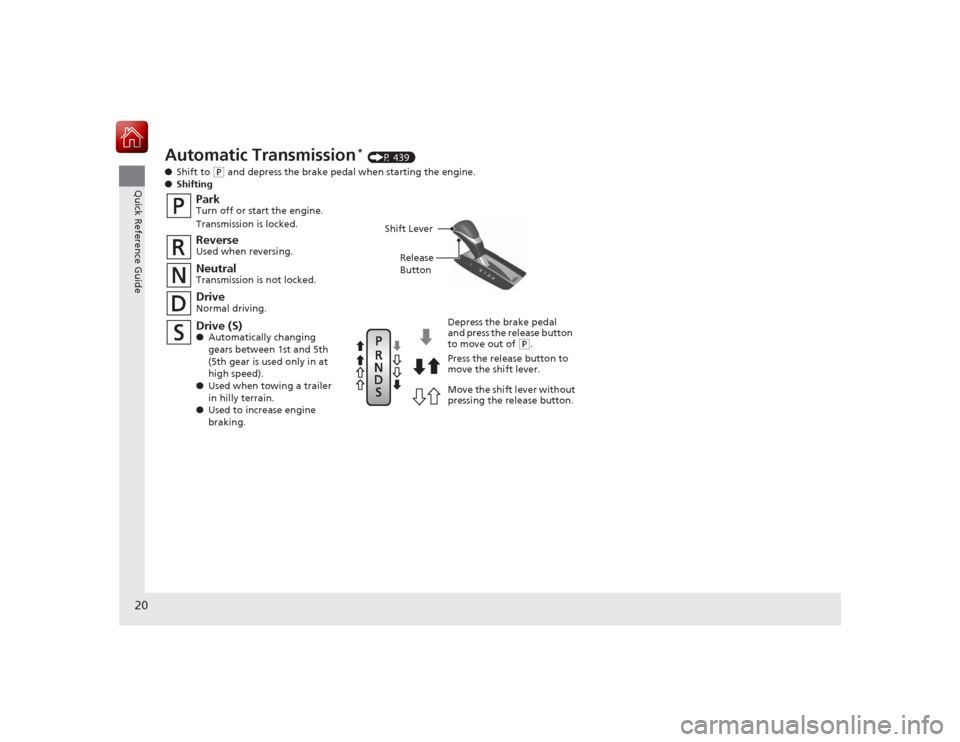
20Quick Reference Guide
Automatic Transmission
* (P 439)
● Shift to
(P and depress the brake pedal when starting the engine.
● Shifting
ParkTurn off or start the engine.
Transmission is locked.NeutralTransmission is not locked.Drive (S)● Automatically changing
gears between 1st and 5th
(5th gear is used only in at
high speed).
● Used when towing a trailer
in hilly terrain.
● Used to increase engine
braking.
Depress the brake pedal
and press the release button
to move out of
(P.
Press the release button to
move the shift lever.
Move the shift lever without
pressing the release button.
ReverseUsed when reversing.DriveNormal driving.
Shift Lever
Release
Button
Page 22 of 593
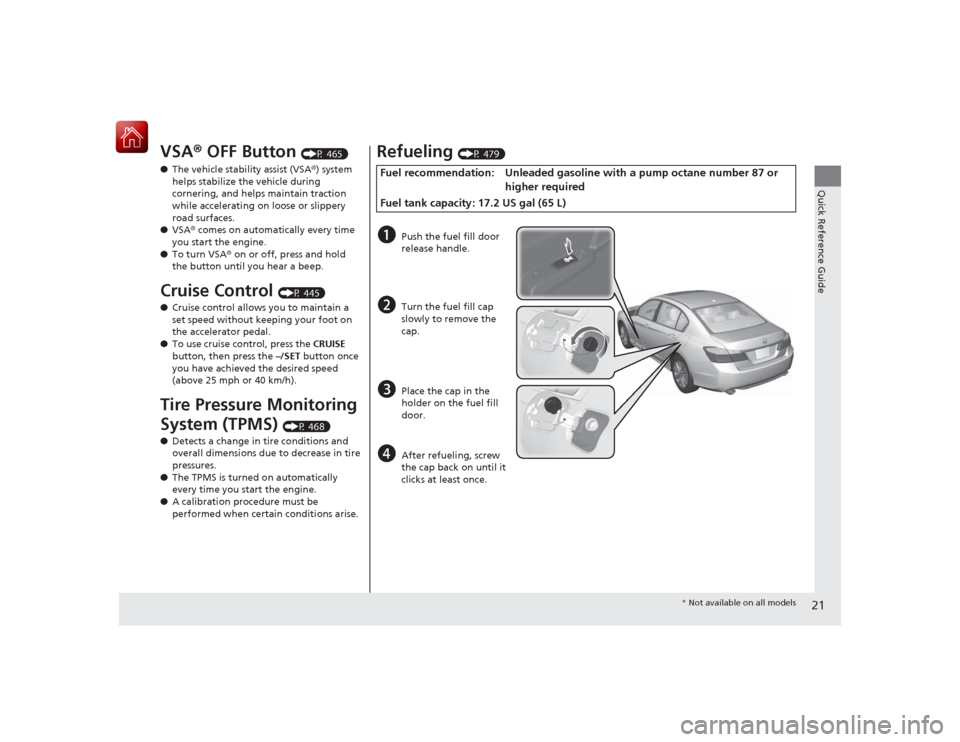
21Quick Reference Guide
VSA® OFF Button
(P 465)
● The vehicle stability assist (VSA ®) system
helps stabilize the vehicle during
cornering, and helps maintain traction
while accelerating on loose or slippery
road surfaces.
● VSA ® comes on automatically every time
you start the engine.
● To turn VSA ® on or off, press and hold
the button until you hear a beep.
Cruise Control
(P 445)
● Cruise control allows you to maintain a
set speed without keep ing your foot on
the accelerator pedal.
● To use cruise control, press the CRUISE
button, then press the –/SET button once
you have achieved the desired speed
(above 25 mph or 40 km/h).
Tire Pressure Monitoring
System (TPMS)
(P 468)
● Detects a change in tire conditions and
overall dimensions du e to decrease in tire
pressures.
● The TPMS is turned on automatically
every time you start the engine.
● A calibration procedure must be
performed when certain conditions arise.
Refueling
(P 479)
Fuel recommendation: Unle aded gasoline with a pump octane number 87 or
higher required
Fuel tank capacity: 17.2 US gal (65 L)a
Push the fuel fill door
release handle.
b
Turn the fuel fill cap
slowly to remove the
cap.
c
Place the cap in the
holder on the fuel fill
door.
d
After refueling, screw
the cap back on until it
clicks at least once.
* Not available on all models
Page 23 of 593
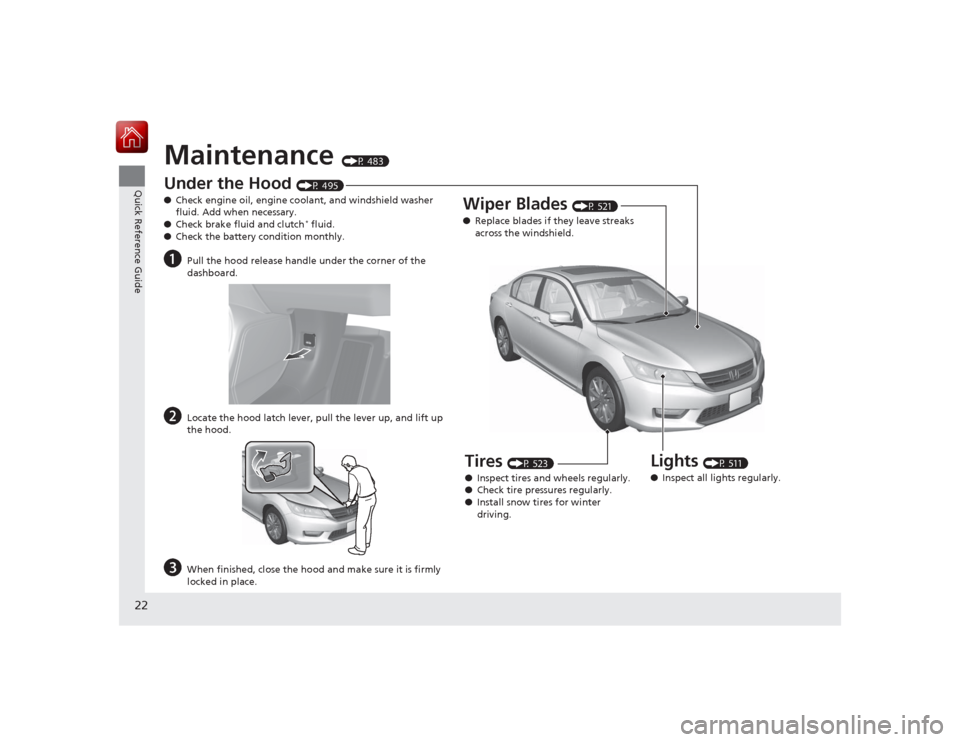
22Quick Reference Guide
Maintenance
(P 483)
Under the Hood
(P 495)
● Check engine oil, engine coolant, and windshield washer
fluid. Add when necessary.
● Check brake fluid and clutch* fluid.
● Check the battery condition monthly.
a
Pull the hood release handle under the corner of the
dashboard.
b
Locate the hood latch lever, pull the lever up, and lift up
the hood.
c
When finished, close the hood and make sure it is firmly
locked in place.
Lights
(P 511)
● Inspect all lights regularly.
Wiper Blades
(P 521)
● Replace blades if they leave streaks
across the windshield.
Tires
(P 523)
● Inspect tires and wheels regularly.
● Check tire pressures regularly.
● Install snow tires for winter
driving.
Page 24 of 593
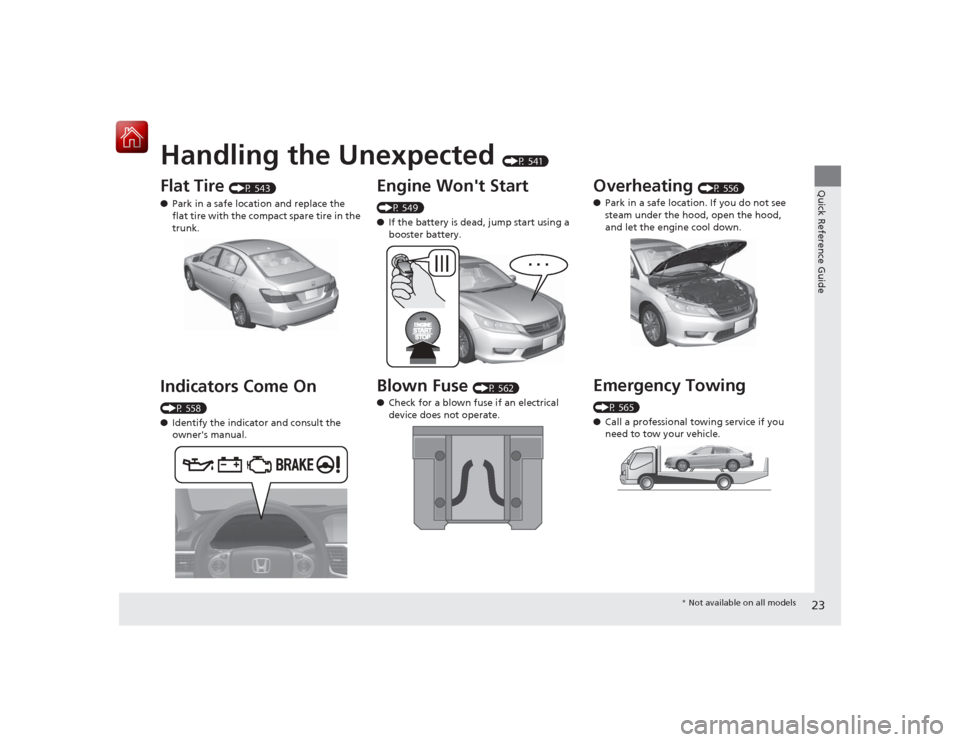
Quick Reference Guide23
Handling the Unexpected
(P 541)
Flat Tire
(P 543)
● Park in a safe location and replace the
flat tire with the compact spare tire in the
trunk.
Indicators Come On (P 558)
●Identify the indicator and consult the
owner's manual.
Engine Won't Start (P 549)
●If the battery is dead, jump start using a
booster battery.Blown Fuse
(P 562)
● Check for a blown fuse if an electrical
device does not operate.
Overheating
(P 556)
● Park in a safe location. If you do not see
steam under the hood, open the hood,
and let the engine cool down.
Emergency Towing (P 565)
●Call a professional towing service if you
need to tow your vehicle.
* Not available on all models
Page 25 of 593
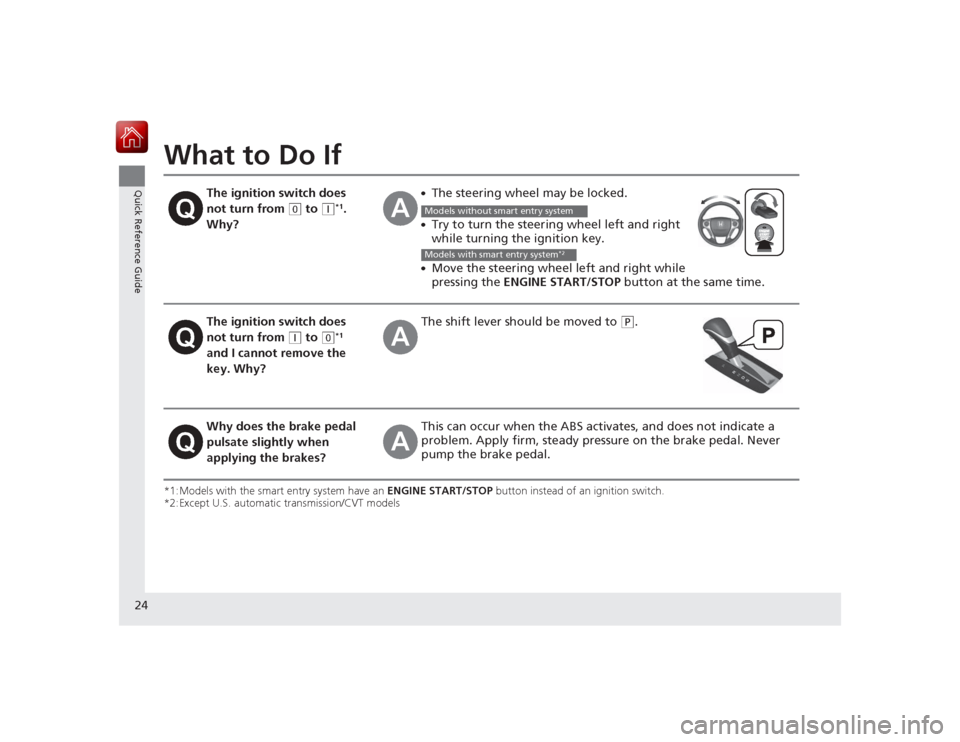
24Quick Reference Guide
What to Do If*1:Models with the smart entry system have an ENGINE START/STOP button instead of an ignition switch.
*2:Except U.S. automatic transmission/CVT models
The ignition switch does
not turn from
(0
to
(q
*1.
Why?
●The steering wheel may be locked.●Try to turn the steering wheel left and right
while turning the ignition key.●Move the steering wheel left and right while
pressing the ENGINE START/STOP button at the same time.
The ignition switch does
not turn from
(q
to
(0
*1
and I cannot remove the
key. Why?
The shift lever s hould be moved to
(P
.
Why does the brake pedal
pulsate slightly when
applying the brakes?
This can occur when the ABS act ivates, and does not indicate a
problem. Apply firm, steady pressure on the brake pedal. Never
pump the brake pedal.Models without smart entry systemModels with smart entry system
*2
Page 26 of 593

25Quick Reference Guide
The rear door cannot be
opened from inside the
vehicle. Why?
Check if the childproof lock is in
the lock position. If so, open the
rear door with the outside door
handle.
To cancel this function, push the
lever to the unlock position.
Why do the doors lock
after I unlocked the doors
using a remote
transmitter?
If you do not open the doors within 30 seconds, the doors are
relocked automatically for security.
Why does the beeper
sound when I open the
driver's door?
The beeper sounds when:●The key is left in the ignition switch
*.
●The power mode
* is in ACCESSORY.
●The exterior lights are left on.
Why does the beeper
sound when I start driving?
The beeper sounds when:●Driver and/or front passenger are not wearing their seat belts.●The parking brake lever is not fully released.
Why do I hear a screeching
sound when I apply the
brake pedal?
The brake pads may need to be replaced. Have your vehicle
inspected by a dealer.
* Not available on all models
Page 27 of 593

26
Page 28 of 593

27
Safe Driving
You can find many safety recommendations throughout this chapter, and throughout this manual.
For Safe Driving
Important Safety Precautions ............. 28
Your Vehicle's Safety Features............ 30
Seat Belts About Your Seat Belts ........................ 32
Fastening a Seat Belt .......................... 35
Seat Belt Inspection............................ 38
Airbags Airbag System Components ............... 39
Types of Airbags ................................ 42
Front Airbags (SRS) ............................ 42
Side Airbags....................................... 46 Side Curtain Airbags .......................... 48
Airbag System Indicators.................... 49
Airbag Care ....................................... 51
Child Safety Protecting Child Passengers ............... 52
Safety of Infants and Small Children ....... 54Safety of Larger Children ................... 62
Exhaust Gas Hazard Carbon Monoxide Gas ....................... 64
Safety Labels Label Locations .................................. 65
Page 29 of 593
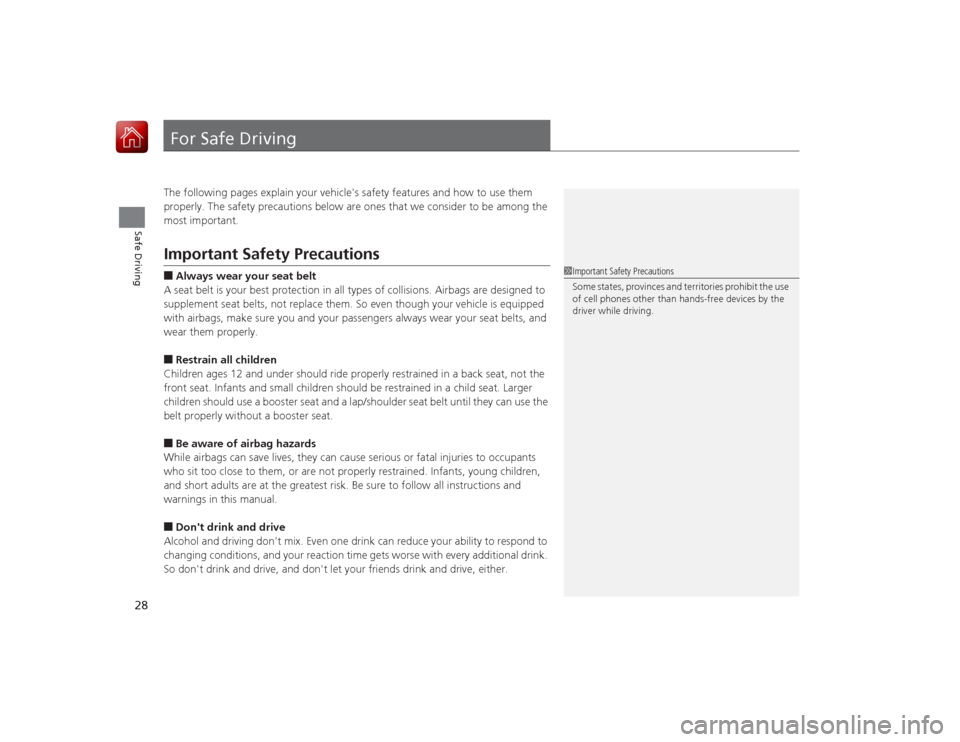
28Safe Driving
For Safe DrivingThe following pages explain your vehicle's safety features and how to use them
properly. The safety precautions below are ones that we consider to be among the
most important.Important Safety Precautions■Always wear your seat belt
A seat belt is your best protection in all types of collisions. Airbags are designed to
supplement seat belts, not replace them. So even though your vehicle is equipped
with airbags, make sure you and your passengers always wear your seat belts, and
wear them properly.■Restrain all children
Children ages 12 and under should ride properly restrained in a back seat, not the
front seat. Infants and small children should be restrained in a child seat. Larger
children should use a booster seat and a lap/shoulder seat belt until they can use the
belt properly without a booster seat.■Be aware of airbag hazards
While airbags can save lives, they can cause serious or fatal injuries to occupants
who sit too close to them, or are not properly restrained. Infants, young children,
and short adults are at the greatest risk. Be sure to follow all instructions and
warnings in this manual.■Don't drink and drive
Alcohol and driving don't mix. Even one drin k can reduce your ability to respond to
changing conditions, and your reaction time gets worse with every additional drink.
So don't drink and drive, and don't let your friends drink and drive, either.
1 Important Safety Precautions
Some states, provinces and territories prohibit the use
of cell phones other than hands-free devices by the
driver while driving.
Page 30 of 593
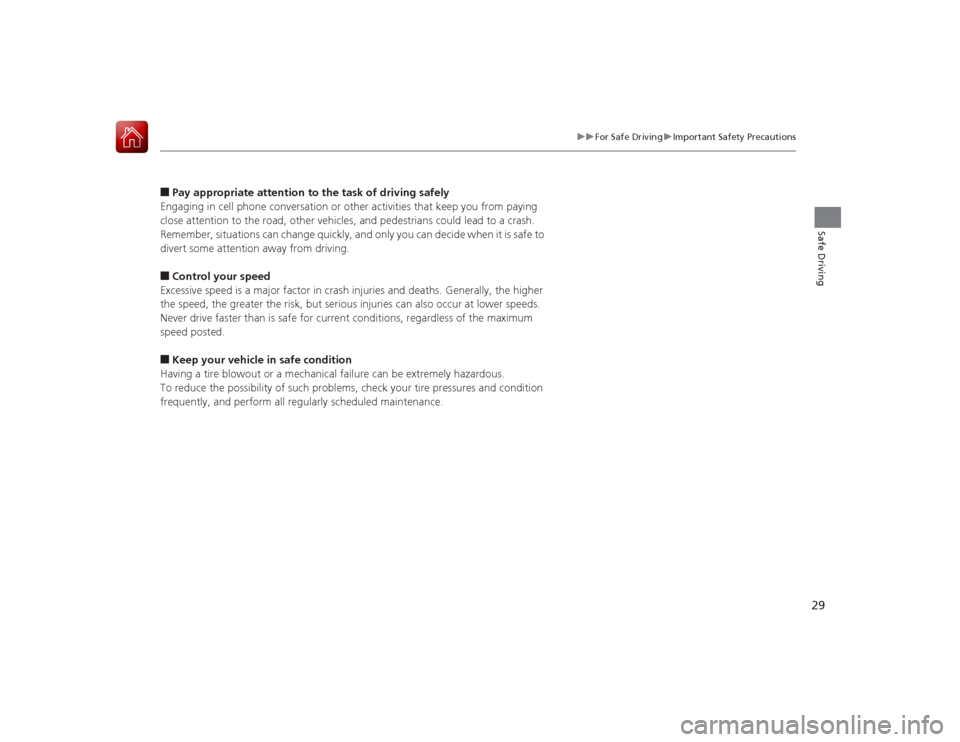
29
uuFor Safe Driving uImportant Safety Precautions
Safe Driving
■Pay appropriate attention to the task of driving safely
Engaging in cell phone conversation or other activities that keep you from paying
close attention to the road, other vehicles, and pedestrians could lead to a crash.
Remember, situations can change quickly, and only you can decide when it is safe to
divert some attention away from driving.■Control your speed
Excessive speed is a major factor in crash injuries and deaths. Generally, the higher
the speed, the greater the risk, but serious injuries can also occur at lower speeds.
Never drive faster than is safe for current conditions, regardless of the maximum
speed posted.■Keep your vehicle in safe condition
Having a tire blowout or a mechanical failure can be extremely hazardous.
To reduce the possibility of such problems, check your tire pressures and condition
frequently, and perform all regularly scheduled maintenance.